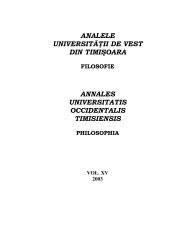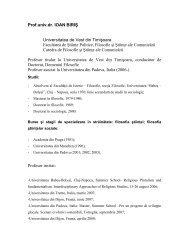VOL. IV (XXI) 2009 - Departamentul de Filosofie si Stiinte ale ...
VOL. IV (XXI) 2009 - Departamentul de Filosofie si Stiinte ale ...
VOL. IV (XXI) 2009 - Departamentul de Filosofie si Stiinte ale ...
Create successful ePaper yourself
Turn your PDF publications into a flip-book with our unique Google optimized e-Paper software.
ADINA BAYA 99<br />
theorizes as the “medicalization” of consumption 24 driven by an obses<strong>si</strong>ve<br />
concern for one’s health. “Homo consumericus” turns more and more into<br />
“homo sanitas”—a person who not only is prone to large-sc<strong>ale</strong> consumption<br />
of medicines, but also of press articles or televi<strong>si</strong>on shows on health-related<br />
issues. The TV and radio’s omnipresent voices in White Noise often fill this<br />
need in particular. From how to “<strong>si</strong>t half lotus and think about our spines” to<br />
“getting mixed messages about my sexuality” or all about “excesses of salt,<br />
phosphorous, magne<strong>si</strong>um,” media is an unremitting resource of data<br />
regarding people’s phy<strong>si</strong>cal or emotional well-being 25 . The recurrent<br />
discus<strong>si</strong>ons in the Gladney family on such issues, including whether Babette<br />
should chew gum or not, what are the causes for her memory loss, or what is<br />
the latest medical advice her daughter Denise found in the “Phy<strong>si</strong>cian’s Desk<br />
Reference,” serve as evi<strong>de</strong>nce for the i<strong>de</strong>ntification of the Gladneys as<br />
hyperconsumers <strong>de</strong>eply preoccupied with healthiness. Their perpetual<br />
concern for adopting ways of eating and living that would limit the pos<strong>si</strong>bility<br />
of contracting any diseases is consequent to the advent of a “religion of<br />
health,” 26 in the name of which people should constantly research and<br />
evaluate the risks posed by the products they consume, regularly consult<br />
with medical practitioners, correct their living habits and try to postpone the<br />
effects of ageing for as long as pos<strong>si</strong>ble.<br />
Finding and preserving health and happiness are regar<strong>de</strong>d as duties<br />
by hyperconsumers, which explains the attractive aura of a drug that would<br />
facilitate both, albeit superficially, only from an apparent perspective. As<br />
Baudrillard believes:<br />
“[…] consumerist man [l'hommeconsommateur] regards<br />
enjoyment as an obligation; he sees himself as an enjoyment<br />
and satisfaction bu<strong>si</strong>ness. He sees it as his duty to be happy,<br />
loving, adulating/adulated, charming/charmed, participative,<br />
euphoric and dynamic. This is the principle of maximizing<br />
existence by multiplying contacts and relationships, by intense<br />
use of <strong>si</strong>gns and objects, by systematic exploitation of all the<br />
potentialities of enjoyment.” 27<br />
With its capacity to annihilate fear of <strong>de</strong>ath, though obviously not<br />
eradicating the cause of <strong>de</strong>ath as such, Dylar is precisely the type of drug<br />
that would be found in the “drugstores of happiness.” A<br />
“psychopharmaceutical” pill, meant to interact with the human cortex, Dylar is<br />
“not just a powerful tranquilizer,” but one that “interacts with<br />
neurotransmitters in the brain that are related to the fear of <strong>de</strong>ath.” 28 The use<br />
of such psychotropic medicines can be interpreted, according to<br />
24 Lipovetsky, 2007, p. 43-45 (My translation).<br />
25 DeLillo, 1986, p. 7, 90, 106.<br />
26 Lipovetsky, 2007, p. 45 (My translation).<br />
27 Baudrillard, 1998, p. 81<br />
28 DeLillo, 1986, p. 90




